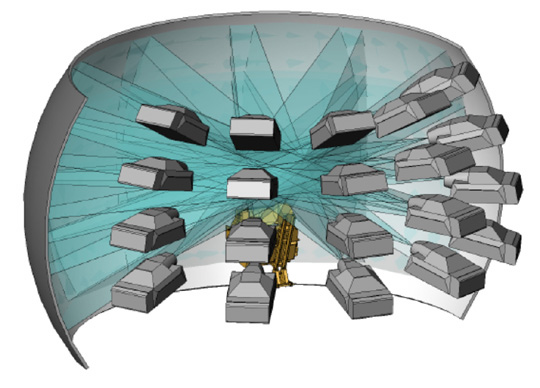|
|
 |

|
 |
 |
Current visual standards date to WWII, or earlier, and may not be valid for modern Air Force missions. The OBVA program is designed to address this issue through the development of an ultra-high-resolution flight simulation laboratory that will be used to assess pilot visual performance in realistic operational scenarios. To achieve this objective, a visual simulation system with "20/13" resolution is required ("20/10" desired - average entry pilot acuity is 20/13). Achieving even "20/20" display resolution is technically challenging over a wide field of view required for an immersive simulation environment. This technical challenge and a detailed examination of minimally acceptable fidelity requirements are being addressed under the current phase of the effort.
Program funding is being provided by AF/SGR and managed by the 711th Human Performance Wing (HPW) and USAFSAM. Based on the results of the concept refinement phase, AF/SGR approved Milestone A decision in August 2008. OBVA is currently in its technology development phase. This phase will focus on development of experimental methodologies/test scenarios, and validation of the approach through demonstration of quantitative correlation between visual and operational performance. In addition, in this phase we will develop databases for visual component testing, visual simulation component evaluations, a final simulator system configuration, and documentation of results. This technology development phase is scheduled to end around August 2010 and followed by Milestone B decision. With Milestone B approval, the system development and demonstration phase will follow resulting in an operational laboratory at Wright-Patterson AFB planned for 2013. A multi-year research effort will ensue with emphasis on operational assessments of clinical standards.
The development of the OBVA laboratory relies on the truly unique expertise available only through NASA Ames and 711 HPW government and contractor scientists and engineers. OBVA not only supports the development of validated clinical visual assessment for Air Force pilot selection, but also furthers the development of next-generation immersive decision environments for wider Air Force training use.
|
| |
 |
 |
The Part-Task Flight Simulator will be used by NASA researchers and USAF pilots for planned Operational Based Vision Assessment (OBVA) studies. The part-task simulator at NASA includes a simple cockpit with very basic flight controls and F16 aerodynamics software with 6-DOF equations of motion logic developed by NASA. The part-task simulator employs commercially available, off-the-shelf visual subsystem components but specially configured to provide the viewer with eye limiting visual acuity (that is, 20-10 vision system resolution). Additionally, the simulator employs special hardware to help minimize smearing / blurring artifacts to the human retina. These undesirable artifacts are generated by the human eye anatomy due to the very long pixel persistence hold times by state-of-the-art projection subsystems that provide extraordinarily bright pictures at very high resolution and which accomplish this by holding the pixels on for nearly the full frame time (e.g., 16-milliseconds).
By generating the equivalent of 20-10 visual acuity within the visual system hardware of the OBVA lab, fighter pilots with extraordinary vision will for the first time be able to actually see everything in the computer generated world at the same visual resolution they would see in the real-world. Most modern day U.S. Department of Defense simulators only today provide approximately 20-70 visual acuity, so this simulator will be used to help identify what operational capabilities of the USAF warfighter might be lost (if any) during training because of limitations found within many visual system components. |
| |
 Current OBVA Part-Task Simulator
Current OBVA Part-Task Simulator
|
| |
 Potential Configuration for Final OBVA Simulator
Potential Configuration for Final OBVA Simulator
|
|
|